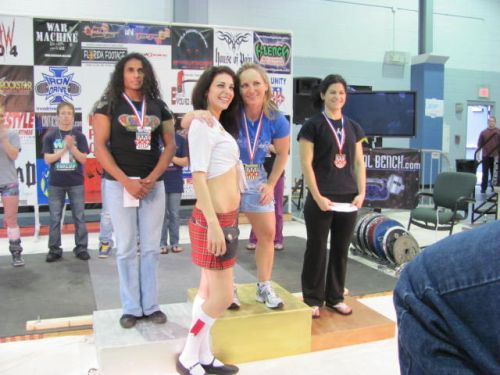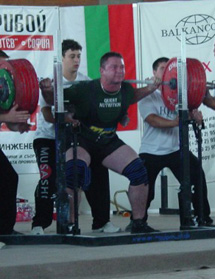Starting RTS Part II
by Mike Tuchscherer

In part one of this article, I discussed intensity and its role in the training process. Remember, intensity dictates a large portion of the training effect. Now would like to discuss with you how to auto-regulate your training volumes to produce optimal training results.
But first, I would like to discuss why auto-regulation is important. You see each person responds to training differently. We all know people who can handle large amounts of volume and seemed to be unaffected. We all also know someone who cannot handle such large volumes without overtraining. It's important to realize that there is a whole range of training that is neither under training no or overtraining. And what's more -- there us a sweet spot somewhere in the middle that will produce the greatest training effect.
So how do you figure out where the sweet spot is, since it will be different for each person? The answer is auto-regulation. With auto-regulation, training volumes automatically adjust depending on what's best for you. There are no guessing games; much less "trial and error". There are several ways to auto-regulate training, but the common method used in Reactive Training Systems is called Fatigue Percents. This method has a lot of benefits for the user. Not only is volume automatically adjusted to the needs and fitness levels of the lifter, this adjustment will occur in real time. This means if you are feeling sick, volume will be adjusted. If you are not getting any sleep, volume will be adjusted. This is a very powerful training tool that you can use to enhance your training every day!
Focus, Mike! Gimme something I can use!
When using fatigue percents, you're trying to measure a loss in your ability to move weights. If you've first implemented the RPE system I discussed in the first article, this will be much easier to understand.
Look at your protocol for the day. From the previous article, let's say you plan on doing sets of 3 reps from an 8 to 9 RPE and you plan on using a 5% fatigue percent (more on this later - 5% is fairly average). We know this means 1 to 3 reps in the tank on all work sets. Start your session by working up to your top set. In this example, that's a set of 3 at a 9 RPE. Let's say you do 405. Now you apply your fatigue percent. If you subtract 5% from your top set, you get about 385. What this means is that you will continue to work until 385 for 3 reps yields a 9 RPE. This is a 5% loss in your ability to move weight and it correlates with a certain level of fatigue. This may require many sets or only a few. Each workout will be different, as will each movement. But that's the point - your volume will automatically adjust up or down to accommodate what your body can handle. This will help you avoid overtraining and ensure that you're getting enough volume for adaptation to occur.
Free Samples!
I like to teach with examples, so let's work through a hypothetical situation. Let's say our lifter is supposed to Squat, doing sets of 2 reps at 8-9 RPE's, with a 5% fatigue percent. So he goes to the gym, fills up his water bottle and stakes out his Power Rack. The poor guy trains at a commercial gym, so he has to wait until the Shrug Brothers finish their shoulder-spasms (hey, it's my hypothetical situation - I can do what I want).
When he finally gets settled in to the rack, he goes through his warm-up the way he normally does. The warm-up is followed by a work up to the heaviest weight of the day - in this case a weight that he will do a set of 2 reps that results in a 9 RPE. Let's say our hypothetical lifter gets up to 525x2 @9 RPE. At this point, he applies his fatigue percent - 5%. He finds that 5% of 525 is about 26 pounds. So he subtracts 26 from 525 and rounds it to a weight he can load - 500. What this means is he will keep working until he does 500x2 @9. This shows a 5% loss in his ability to lift.
There are a few ways to go about reaching that level of fatigue. The most simple way is to load 500 pounds and do repeated sets of two reps until the RPE climbs up to a 9. At that point, you would stop. The other way is to slowly descend the weight, doing a double on each set, until you get down to 500x2 @9. It doesn't much matter how you arrive at 500x2 @9 - only that you get there.

Keys to implementation
If this sounds like an easy system to cheat on, you'd be right. If you're a lazy person, this isn't for you. If you have to be pulled out of the gym with a pry bar, this probably isn't for you either. This method caters to those I call “controlled-aggressive”. You have to be willing to work hard - very hard - to achieve your goals. But if you're more interested going nuts than being productive, there's not much any system can do for you. Simply put, if you work hard to get stronger, but you also put some thought in your training, this system can be helpful to you.
One thing to keep in mind - keep your rest intervals under control. There will be a wide range of effective rest intervals, but if you rest too long for the intensity of work you are doing, you will never get the fatigue you're after. The key to mitigating this is just to pay attention. Don't take 10 minutes between sets unless you have a good reason!
RPE's play a critical role in implementing this system of training. If you missed the discussion on RPE's, check out the previous edition of Power, or visit the RTS website for more information.
For a deeper understanding on how to use Fatigue Percents, including information on how to vary the percentages in accordance with your training goals, check out the Reactive Training Manual or visit our forum at www.ReactiveTrainingSystems.com. There is a lot we can all learn from one another, so join in the discussion!
Mike Tuchscherer is the owner of Reactive Training Systems, a company dedicated to individualized physical training. The goal of RTS is to help you become a dominant force in your sport! Learn more by visiting www.ReactiveTrainingSystems.com.
Mike himself is an accomplished Powerlifter. He has over 12 years of experience training and researching the best training methods in the world. Mike has competed in raw and single ply competitions. He recently won the Gold medal representing the USA at the 2009 World Games; becoming the first American male to ever win this distinction. His best lifts in IPF competition are a 903 squat, a 644 bench press, an 826 deadlift, and a 2342 total in the 275 pound weight class.
More Articles By Mike Tuchscherer
Return to the Workout Articles Archive
|